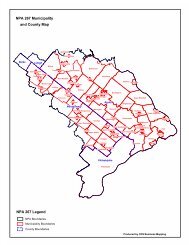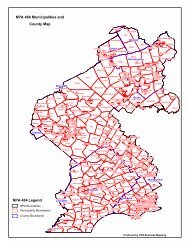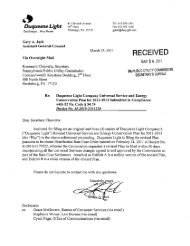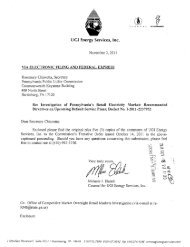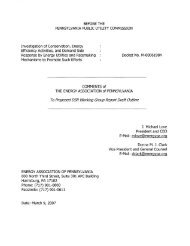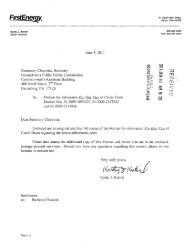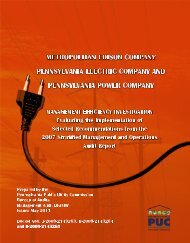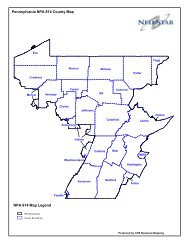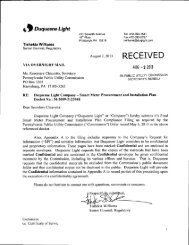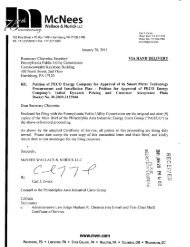2010 Report - Pennsylvania Public Utility Commission
2010 Report - Pennsylvania Public Utility Commission
2010 Report - Pennsylvania Public Utility Commission
You also want an ePaper? Increase the reach of your titles
YUMPU automatically turns print PDFs into web optimized ePapers that Google loves.
suppliers or purchased power from the wholesale market to fulfill their provider of last resort(POLR) obligations. 23It is the responsibility of each load serving entity to make provisions for adequate generatingresources to serve its customers. Furthermore, Section 2807(e)(3) of the <strong>Public</strong> <strong>Utility</strong> Coderequires that, at the end of the transition period (the period in which the EDC recovers its strandedcosts), the local EDC or <strong>Commission</strong>-approved alternate supplier must acquire electric energy,pursuant to a <strong>Commission</strong>-approved competitive procurement process, for customers who contractfor power which is not delivered, or for customers who do not choose an alternate supplier. Theacquired electric power must include a prudent mix of spot market purchases, short-term contractsand long-term purchase contracts, designed to ensure adequate and reliable service at the least costto customers over time. EDCs must also assume the role of provider of last resort for customerschoosing to return to the EDC. 24On May 10, 2007, the <strong>Commission</strong> finalized the statewide default service rulemaking and policystatement which provides guidelines to default service providers regarding the acquisition ofelectric generation supply, the recovery of associated costs and the integration of default servicewith competitive retail electric markets. The regulations establish the criteria on how electricgeneration service is provided to customers who choose to obtain generation service from analternate supplier. In reviewing the comments and considering revisions to the proposed defaultservice rules, the <strong>Commission</strong> recognized that some elements of the default service rules should beaddressed in a policy statement that provides guidance to the industry rather than strict rules. 25The transition periods have expired for seven of the 11 EDCs, PPL being the latest EDC to end itsrecovery of stranded costs on Dec. 31, 2009.The electric generation supplier (EGS) market share for the fourth quarter of 2009 may beconsidered indicative of the overall current status of customer choice in <strong>Pennsylvania</strong>. In theaggregate, the EGS share of total megawatthour (MWh) sales was 11.7 percent, varying greatlyamong the individual EDC service territories. EGSs supplied 3.3 percent of residential sales; EGScommercial and industrial sales were substantially higher at 16.1 percent of total sales. As of April8, <strong>2010</strong>, there were 99 licensed EGS offering generation services to retail customers in<strong>Pennsylvania</strong>.Alternative Energy Portfolio StandardsAct 213 26 requires that EDCs and EGS acquire alternative energy credits (AECs) in quantitiesequal to an increasing percentage of electricity sold to retail customers. AECs are separate fromthe electricity that is sold to customers. An AEC represents one MWh of qualified alternativeelectric generation or conservation, whether self-generated, purchased along with the electriccommodity or separately through a tradable instrument. 2723 Also referred to as “obligation to serve” and “default service.”24 66 Pa.C.S. § 2807(e)(3).25 Docket Nos. L-00040169 and M-00072009; 52 Pa. Code §§ 54.4-54.6, 54.31-54.41, 54.123, 54.181-54.189, 57.178and 69.1801-69.1817.26 Alternative Energy Portfolio Standards Act, effective Feb. 28, 2005; 73 P.S. §§ 1648.1–1648.8.27 See 52 Pa. Code §§ 75.61—75.70.14<strong>Pennsylvania</strong> <strong>Public</strong> <strong>Utility</strong> <strong>Commission</strong>



